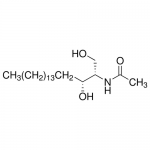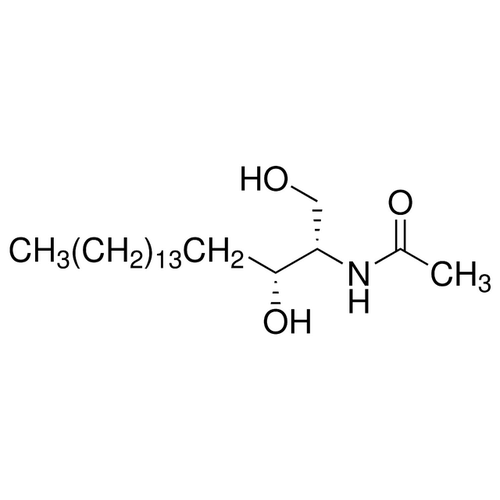| Product Name | Dihydroceramide |
| Description |
Autophagy inducer |
| Purity | >98% |
| CAS No. | 13031-64-6 |
| Molecular Formula | C20H41NO3 |
| Molecular Weight | 343.54 |
| Field of Use | Not for use in humans. Not for use in diagnostics or therapeutics. For in vitro research use only. |
Properties
| Storage Temperature | -20ºC |
| Shipping Temperature | Shipped Ambient |
| Product Type | Inducer |
| Solubility | Soluble in ethanol (5 mg/ml) or DMSO (5 mg/ml: dissolve in hot DMSO, then cool to RT). |
| Source | Synthetic |
| Appearance | White solid. |
| SMILES | [C@@H](NC(=O)C)([C@H](O)CCCCCCCCCCCCCCC)CO |
| InChI | InChI=1S/C20H41NO3/c1-3-4-5-6-7-8-9-10-11-12-13-14-15-16-20(24)19(17-22)21-18(2)23/h19-20,22,24H,3-17H2,1-2H3,(H,21,23)/t19-,20+/m0/s1 |
| InChIKey | CRJGESKKUOMBCT-VQTJNVASSA-N |
| Safety Phrases |
Classification: Not WHMIS controlled. Safety Phrases: S22 - Do not breathe dust. S24/25 - Avoid contact with skin and eyes. S36/37/39 - Wear suitable protective clothing, gloves and eye/face protection. |
| Cite This Product | Dihydroceramide (StressMarq Biosciences Inc., Victoria BC CANADA, Catalog # SIH-398) |
Biological Description
| Alternative Names | C2 Dihydroceramide, D-erythro-N-Acetylsphinganine |
| Research Areas | Autophagy, Cancer |
| PubChem ID | 6610273 |
| Scientific Background | Dihydroceramide is a precursor in the ceramide biosynthesis pathway and plays a key role in sphingolipid metabolism. In neuroscience, dihydroceramide has gained attention for its involvement in cellular stress responses, apoptosis, and autophagy—processes that are dysregulated in neurodegenerative diseases. Altered levels of dihydroceramide have been linked to mitochondrial dysfunction and oxidative stress in neuronal cells. Its role in modulating membrane dynamics and signaling pathways makes it a valuable molecule for studying lipid-mediated mechanisms in neurodegeneration and brain aging. |
| References |
1. Gagliostro, V. et al. (2012). Int J Biochem Cell Biol, 44(12): 2135-43. 2. Jiang, Q. et al. (2012). Int J Cancer, 130(3): 685-93. 3. Signorelli, P. et al. (2009). Cancer Lett, 282(2): 238-43. |



Reviews
There are no reviews yet.